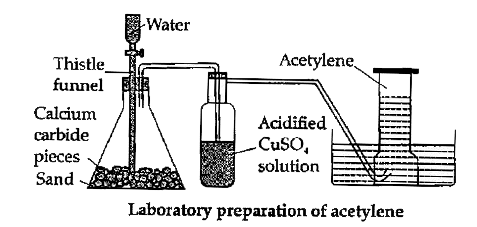When zinc granule is dipped into copper sulphate solution, copper is precipitated because :
Both, copper and zinc have a positive reduction potential
Reduction potential of copper is higher than that of zinc
Reduction potential of zinc is higher than that of copper
Both, zinc and copper have a negative reduction potential
The correct Answer is:B
To solve the question of why copper is precipitated when zinc granules are dipped into copper sulfate solution, we can break it down into several steps:
1. Identify the Reaction:
When zinc (Zn) is added to copper sulfate (CuSO₄) solution, a chemical reaction occurs. The reaction can be represented as:
Zn (s)+CuSO4(aq)→ZnSO4(aq)+Cu (s)
2. Type of Reaction:
This reaction is classified as a displacement reaction. In this type of reaction, a more reactive metal displaces a less reactive metal from its compound.
3. Reactivity of Metals:
Zinc is more reactive than copper. This means that zinc has a greater tendency to lose electrons and form positive ions compared to copper. Therefore, zinc can displace copper from copper sulfate.
4. Oxidation and Reduction:
In this reaction:
- Zinc is oxidized from an oxidation state of 0 to +2 (Zn → Zn²⁺ + 2e⁻).
- Copper is reduced from an oxidation state of +2 to 0 (Cu²⁺ + 2e⁻ → Cu).
5. Reduction Potentials:
The standard reduction potentials for the half-reactions are:
- For zinc: Zn2++2e−→Zn has a reduction potential of -0.76 V.
- For copper: Cu2++2e−→Cu has a reduction potential of +0.34 V.
6. Comparison of Reduction Potentials:
The positive reduction potential of copper (+0.34 V) indicates that copper ions have a strong tendency to gain electrons and be reduced. In contrast, the negative reduction potential of zinc (-0.76 V) indicates that zinc has a lesser tendency to be reduced.
7. Conclusion:
Since zinc is more reactive and has a lower reduction potential compared to copper, it can displace copper from copper sulfate solution. As a result, copper is precipitated out of the solution.
Final Answer:
Copper is precipitated because zinc is more reactive than copper and can displace it from copper sulfate solution due to its lower reduction potential.
---
When zinc (Zn) is added to copper sulfate (CuSO₄) solution, a chemical reaction occurs. The reaction can be represented as:
Zn (s)+CuSO4(aq)→ZnSO4(aq)+Cu (s)
This reaction is classified as a displacement reaction. In this type of reaction, a more reactive metal displaces a less reactive metal from its compound.
Zinc is more reactive than copper. This means that zinc has a greater tendency to lose electrons and form positive ions compared to copper. Therefore, zinc can displace copper from copper sulfate.
In this reaction:
- Zinc is oxidized from an oxidation state of 0 to +2 (Zn → Zn²⁺ + 2e⁻).
- Copper is reduced from an oxidation state of +2 to 0 (Cu²⁺ + 2e⁻ → Cu).
The standard reduction potentials for the half-reactions are:
- For zinc: Zn2++2e−→Zn has a reduction potential of -0.76 V.
- For copper: Cu2++2e−→Cu has a reduction potential of +0.34 V.
The positive reduction potential of copper (+0.34 V) indicates that copper ions have a strong tendency to gain electrons and be reduced. In contrast, the negative reduction potential of zinc (-0.76 V) indicates that zinc has a lesser tendency to be reduced.
Since zinc is more reactive and has a lower reduction potential compared to copper, it can displace copper from copper sulfate solution. As a result, copper is precipitated out of the solution.
Copper is precipitated because zinc is more reactive than copper and can displace it from copper sulfate solution due to its lower reduction potential.
Topper's Solved these Questions
Similar Questions
Knowledge Check
When a copper wire is dipped into silver nitrate solution, silver is precipitated because
Aboth silver and copper have positive reduction potentialsBreduction potential of silver is higher than that of copperCreduction potential of copper is higher than that of silverDboth silver and copper have negative reduction potentials.
Which metal can deposit copper from copper sulphate solution ?
View SolutionState one observation: A zinc granule is added to copper sulphate solution.
View SolutionCopper sulphate is soluble in water.
View SolutionOn adding excess of NH4OH to copper sulphate solution
View SolutionExplain the following:
(i). Copper hydroxide is soluble in ammonium hydroxide but not in sodium hydroxide.
(ii). A dark blue precipitate is formed when sodium hydroxide solution is added to copper sulphate solution. The precipitate darkens on heating.
View SolutionWhat happens when a zinc rod is dipped in copper sulfate solution ? Give the reason for this observation.
View Solution
Give the function of acidified copper sulphate solution.
View Solution
